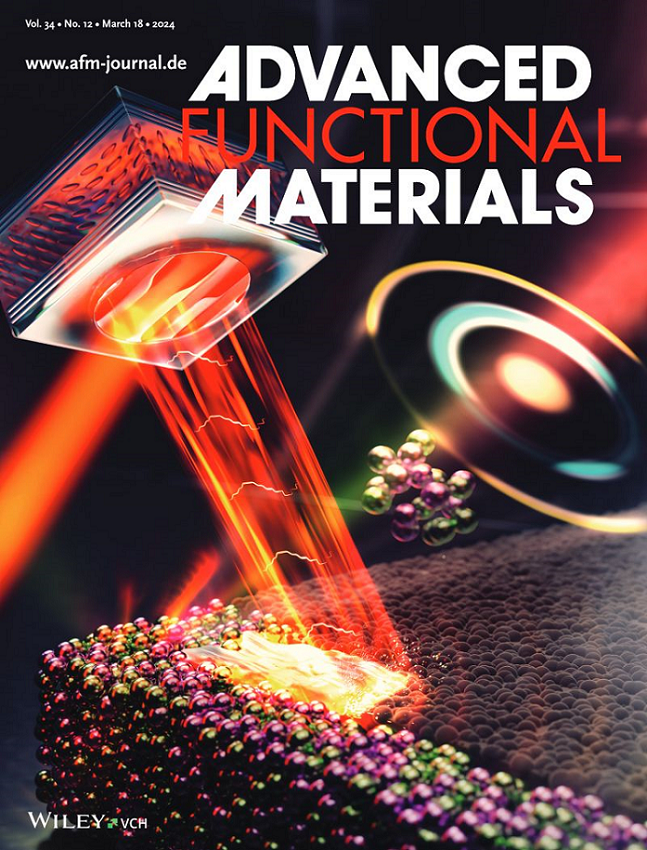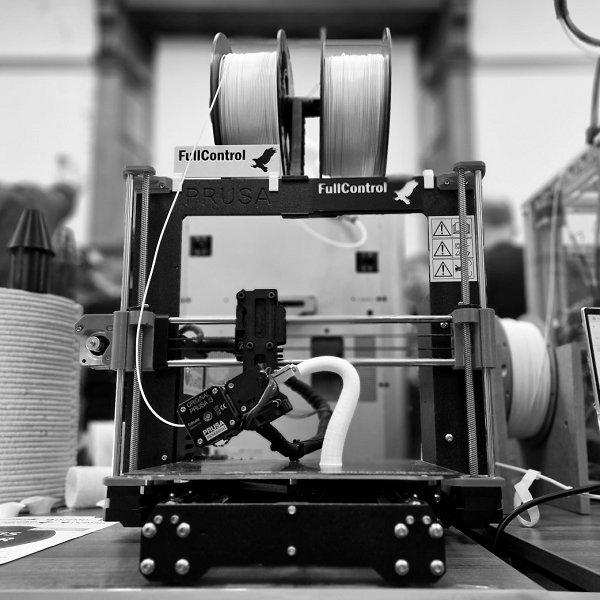We’re starting today’s 3D Printing News Briefs with some research into 3D printed luminescent quantum-dot polymer architectures and free-form laser beam shaping, and then on to an open source 4-axis 3D printer. Next, it’s on to programs: one for free recycling of PLA 3D printing waste, and one for digital dentistry adoption subscriptions. Finally, we’ll end with 3D printed cycling components.
3D Printing Luminescent Quantum Dots with Direct Ink Writing

a) Schematic of the direct-ink writing (DIW) approach of luminescent PQD–polymer architectures. Hydroxypropyl cellulose (HPC) polymer was dissolved in DCM to prepare a 3D printable ink. b) Optical image of the inks as visible in 385-nm ultraviolet (UV) light. PQD–polymer inks display red (R), green (G), and blue (B) emissive colors, corresponding to the halide ratios of CH3NH3PbBr1.5I1.5, CH3NH3PbBr3, and CH3NH3PbBr1.5Cl1.5. The scale bar is 5 mm. c) Schematic of the synthesis of luminescent PQDs as a colloidal dispersion solution in toluene, including the synthesis of PQD-polymer ink with HPC. d) Optical images of the DIW process show continuous deposition of a line pattern on the glass substrate. The scale bar is 1 mm.
Quantum dots (nanoscale semiconductors with light-emitting properties) could revolutionize technologies like biomedical imaging and solar cells, and especially ones made of organic-inorganic perovskite materials, which have properties like color tunability and high quantum yields. But perovskite quantum dots are sensitive to oxygen and heat, so it’s been hard to leverage their capabilities, even with 3D printing. A research team, led by Im Doo Jung at Korea’s Ulsan National Institute of Science and Technology (UNIST), developed a way to 3D print perovskite quantum-dot polymer composites into complex architectures.
Using direct ink writing (DIW), and carefully optimized print parameters, the team encapsulated prefabricated perovskite quantum dots in a hydroxypropyl cellulose polymer matrix. This improved the stability of the dots against oxygen and heat, and also enabled the researchers to fine-tune the rheological properties of the ink for smooth flow during the printing process, as well as rapid solidification after to hold their shape. As described in their paper, the team printed 3D objects like Eiffel towers and pyramids by stacking hundreds of layers of color-emitting quantum dot-polymer ink, and the structures retained the dots’ emission characteristics with no degradation, which shows just how protective the polymer matrix is. Their work could lead to new avenues for optoelectronic and anti-counterfeiting devices.
Advanced Free-Form Laser Beam Shaping for Bulk Metallic Glass AM
A new study by researchers at the Swiss Advanced Manufacturing Center and Montanuniversität Leoben made the cover of Advanced Functional Materials, and is focused on advanced free-form laser beam shaping for 3D printing bulk metallic glass (BMG) alloys. This technique controls the glassy state (motion of molecules is restricted) toward mechanical and structural enhancement, and can improve the productivity of laser powder bed fusion (LPBF), as well as enable 3D printing of other materials with qualities that other machines can’t yet achieve. BMGs are good for a number of applications, and LPBF can produce large, intricate BMG structures, but non-optimal energy distribution in current 3D printers can result in the reheating of previously solid layers, which impacts the mechanical characteristics. By tuning the laser beam, the researchers are able to overcome these difficulties.
As the Swiss Advanced Manufacturing Center wrote in a LinkedIn post, “Using liquid crystal on a silicon device and modifying the laser wavefront, unparalleled flexibility in adjusting laser energy density and melt pool shape during the manufacturing process is possible, enabling manufacturing of near fully amorphous bulk metallic glass parts with enhanced properties previously unattainable with current state-of-the-art machines.”
Open-Source 4-Axis 3D Printer by Loughborough University Researchers
Andrew Gleadall, Senior Lecturer at Loughborough University, worked with two undergraduate students and partners at Duet3D to build an open-source, 4-axis 3D printer, featuring between 4-6 3D printed parts and just 3 purchased parts. The team created a full guidance document that will walk you through the entire build if you want to make your own. Open-source FullControlXYZ software can be used to generate multi-axis toolpaths and Gcode in the guidance document, and everything is available on Github.
“This is a mega simple starting point for multiaxis development… 5-axis mod coming soon! Starting with 4-axis, reduces barriers to development and hopefully is an easy step for slicers towards 5-axis slicers in the future. And there is loads of research you can do with 4 axes that is directly relevant to 5,” Gleadall wrote on LinkedIn. “Whilst waiting for multiaxis slicers to mature, you can use FullControlXYZ 🎉 which has multiaxis demos (https://lnkd.in/ebfXs7Kd).”
Filamentive Recycling PLA 3D Printing Waste for Free
Every year in the 3D printing industry, up to 400,000 kg of plastic waste is generated, and 70% of that is not recycled, due to barriers like prohibitive costs and lack of recycling options. Filamentive is here to change that with its Free PLA 3D Printing Waste Recycling Scheme, making the process of recycling PLA waste free and easy for existing customers. In order to offer this sustainable service by balancing the costs of its new initiative, the company has set a minimum spend threshold of £500 (ex. VAT) on eligible products. Then, for no extra cost, customers can access PLA waste recycling services via the company’s UK partner 3D Printing Waste (3DPW). Filamentive will send a free 45L waste recycling box, and 3DPW will collect it and use various recycling methods to ensure a 100% landfill diversion. This service is only valid for purchases during the period of January 1st, 2024 onwards.
“Most 3D printing waste isn’t recycled, but we’re here to change that. This new scheme now offers our valued customers a viable, cost-free recycling solution to reduce plastic pollution and make sustainable 3D printing an achievable reality,” explained Ravi Toor, Filamentive’s Managing Director. “Whilst this involves a financial commitment from us, we view this not as a cost but instead a necessary investment in our planet’s future.”
Desktop Health’s Digital Dentistry Adoption Subscription Program
Desktop Health has launched a new program for dentists, called ScanUp, that will make adoption of digital technologies simpler, enabling practices to improve their efficiency and patient care. ScanUp has actually been in development since late 2022 through a beta rollout and already has hundreds of dental members nationwide, but this is its rollout to the general dental marketplace. According to The Journal of the American Dental Association, about half the dentists in the U.S. haven’t adopted intraoral scanning for a number of reasons. Members of the 36-month ScanUp subscription program will receive a certified pre-owned (CPO) Align iTero Element Flex scanner, plus access to a full digital dentistry ecosystem with certified training, education, and support. The program is paid for with routine lab expenses through work sent to member dental labs, which are owned by or affiliated with Desktop Health, and these full-service labs are already serving over 12,000 dentists in the U.S.
“ScanUp solves a real challenge for dentists struggling to adopt digital dentistry with a streamlined, easy-to-access solution. We are proud to launch the ScanUp program to support the digital dentistry journey of general practitioner and family dentists for improved practice efficiencies and enhanced patient experiences,” said Lou Azzara, President of Desktop Health and Desktop Labs.
New Scope Artech Wheels Feature 3D Printed Hubs & Textured Rims
Finally, Dutch wheel manufacturer Scope Cycling has introduced two technical innovations for its new carbon fiber Artech wheels: a textured, 3D scale pattern on the rims, and ultralight, 3D printed hub shells. The team was inspired by the lattice structure of bone for the hubs, as it has an excellent strength to weight ratio. They used topology optimization to create the unique design of the hubset, which weighs just 205 g. Scalmalloy, a lightweight scandium alloy, was used to print the hub shells, each of which takes a total of four days to print. That might seem long, but Scope does print 25 at a time. Then, the hubs are machined to the correct tolerance and coated with PVD.
The texture of the rims is akin to fish scales, with larger scales on the outside where the air moves faster, and smaller ones as you get closer to the hub. This smoothes the airflow across the whole rim surface to enable less drag, as well as lend some stability to the wheel. Locally reinforced layups around the spoke holes, rather than the entire bed, reduces weight, and the wheels are laced up with strong, yet lightweight Carbonlite AeroSpokes. All of this, combined with bladed carbon spokes, make for a unique wheelset. The Artech wheels are available in two versions (Road and all Road), and three depths (22 mm, 45 mm, and 65 mm). The MSRP is €3,998, and you can upgrade to CeramicSpeed ceramic bearings for an addition €500.
Subscribe to Our Email Newsletter
Stay up-to-date on all the latest news from the 3D printing industry and receive information and offers from third party vendors.
You May Also Like
3D Printing Webinar and Event Roundup: May 5, 2024
We’ve got a busy week of 3D printing events ahead of us, in Texas, Florida, Washington, D.C., Shanghai, and more. Webinar offerings will cover medical models, PolyJet 3D printing, additive...
High Stakes, High Speed: KVG Acquires 15 Nexa3D HSE 3D Printers to Boost Military Tech
As 3D printing increasingly intersects with defense and military logistics, a new partnership between Nexa3D and mission support logistics firm KVG stresses the growing importance of this technology in strategic...
Construction 3D Printing CEO Reflects on Being Female in Construction
Natalie Wadley, CEO of ChangeMaker3D, could hear the words of her daughter sitting next to her resounding in her head. “Mum, MUM, you’ve won!” Wadley had just won the prestigious...
3D Printing News Briefs, February 17, 2024: Shot Blasting, Service Bureaus, & More
In today’s 3D Printing News Briefs, we’re starting out with post-processing, as SKZ Würzburg is using a shot blast system from AM Solutions for its research. Moving on to business,...




































